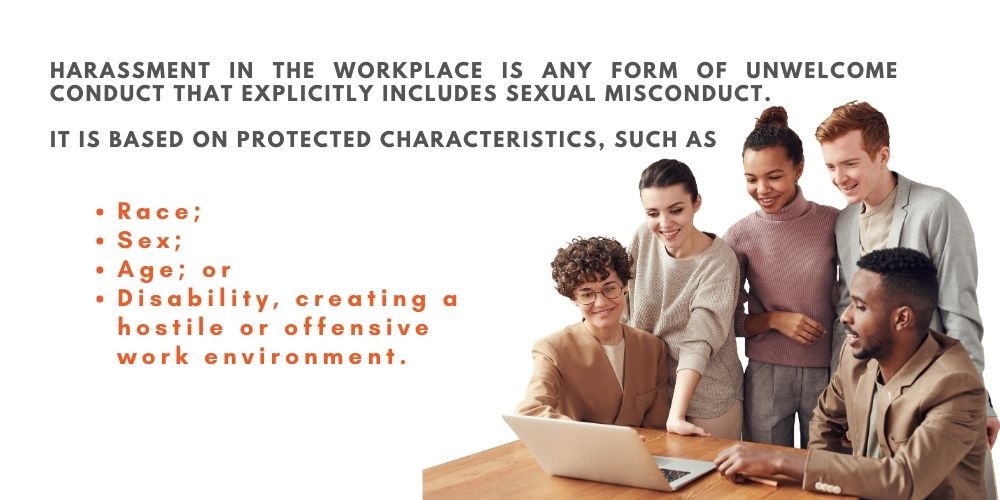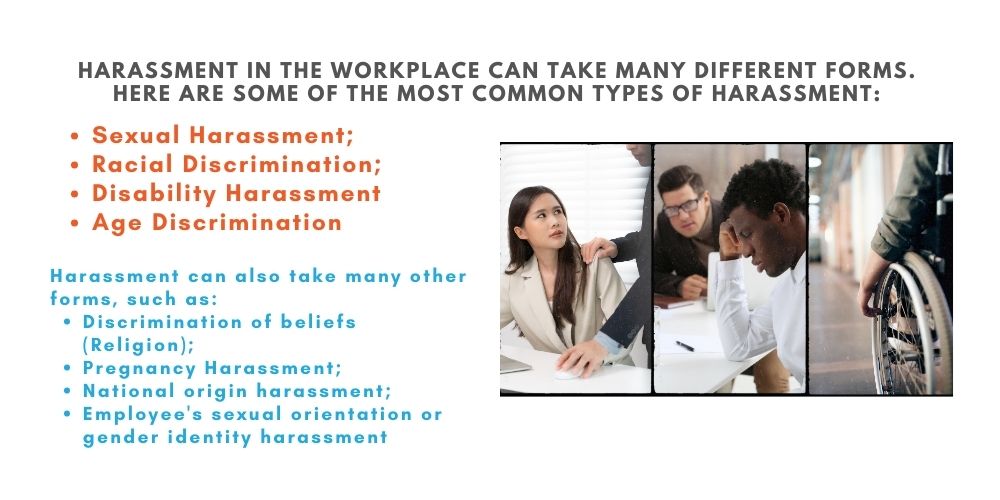Workplace harassment continues to be a pervasive issue across the United States.
Let’s talk stats:
- Approximately 2 million individuals experience workplace violence in the United States on an annual basis.
- In the workplace, 38% of women have experienced sexual harassment.
- 68% of workers across the world do not feel safe at work.
- After speaking up or filing a claim, 55% of victims experience retaliation.
And Chicago has a zero-tolerance stance on sexual harassment.
The Chicago Anti Harassment & Workplace Harassment Training Guide for 2023 provides you with the tools and resources you need for employee education on:
- What harassment is;
- How to prevent it; and
- What to do if it occurs.
Overview Of The The Chicago Anti-Harassment & Workplace Harassment Training
The Chicago Anti Harassment & Workplace Harassment Training Guide for 2023 aims to empower employees with the knowledge to recognize and prevent harassment.
Furthermore, it will help them prevent and respond to harassment in the workplace.
The training program covers a range of topics, including:
- The different types of harassment;
- Employer and employee responsibilities;
- Reporting procedures; and
- Protections against retaliation for reporting harassment.
With this, employers can create a workplace culture of respect and inclusion.
Related Training: US Workplace Harassment Chicago Non-Manager (Course)
What Is Workplace Harassment?
Harassment in the workplace is any form of unwelcome conduct that explicitly includes sexual misconduct.
It is based on protected characteristics, such as
- Race;
- Sex;
- Age; or
- Disability, creating a hostile or offensive work environment.
It can take many forms, including verbal, physical, and visual behavior.
Harassment can have a profound impact on employees, causing them to feel:
- Stressed;
- Anxious and unmotivated.
Furthermore, it can even lead to long-term mental health issues.
You might want to know: Sexual Harassment Training Certification in the United States -2022
Related Course: US Workplace Harassment Chicago Manager (Course)
What Are The Different Types Of Harassment?
Harassment in the workplace can take many different forms. Here are some of the most common types of harassment:
Sexual Harassment
It includes:
- Unwelcome sexual advances;
- Requests for sexual favors;
- Comments or actions based on an employee’s gender and
- Other conduct of a sexual nature.
Racial Harassment
It includes:
- Unwelcome conduct based on an employee’s race;
- Racial slurs;
- Derogatory comments; and
- Actions that create an offensive work environment based on an employee’s race.
Disability Harassment
It includes:
- Unwelcome conduct based on an employee’s disability;
- Actions that create a hostile work environment based on an employee’s disability.
Age Harassment
It includes:
- Age-related stereotypes.
Other Forms Of Harassment
Harassment can also take many other forms, such as:
- Religious harassment;
- Pregnancy Harassment;
- National origin harassment;
- Employee’s sexual orientation or gender identity harassment
It is essential for employers to be aware of all forms of harassment.
They must further work on taking steps to prevent them in the workplace.
Related Course: Sexual Harassment Prevention for Managers (US)
Why Is It Important To Prevent Harassment In The Workplace?
Preventing harassment in the workplace is important for several reasons which our previous article talks about.
Read here: The Importance Of Sexual Harassment Training | Blog – Coggno
Harassment creates a toxic work environment.
It undermines employees’ well-being and damages the organization’s reputation.
And it is essential to promote a healthy and respectful workplace culture.
Furthermore, preventing harassment is good for business.
A workplace culture free from harassment is more likely to
- Attract; and
- Retain talented employees.
Moreover, it can help to foster a positive and productive work environment.
Related Course: Sexual Harassment Training for Managers and Supervisors 3.0 (Course)
What Are The Best Practices For Preventing Harassment In The Workplace?
Preventing harassment in the workplace requires a proactive and comprehensive approach.
Here are some best practices that can help prevent harassment in the workplace:
Develop And Communicate Clear Policies
Employers should have clear policies that:
- Define harassment;
- Outline reporting procedures; and
- Specify consequences for violating the policy.
Furthermore, they must create a written sexual harassment policy.
And they must display a poster advising of the prohibition on sexual harassment where employees can see it.
Provide Offline And Online Training
Employers should provide regular, interactive offline and online training to employees that covers:
- The definition of harassment;
- Reporting procedures; and
- The consequences of harassment.
The training should also provide employees practical skills for addressing and preventing harassment.
Does Online Sexual Harassment Prevention Training Work? Know here.
Foster A Culture Of Respect
Employers should create a culture of respect and inclusivity by promoting the following:
- Workplace diversity;
- Equity; and
- Inclusion.
Employers can achieve this by:
- Celebrating differences;
- Encouraging open communication; and
- Fostering a sense of belonging for all employees.
Encourage Reporting
Employers should encourage employees to report harassment and provide channels for reporting, such as:
- A confidential hotline;
- An anonymous reporting system.
Employers should also ensure that employees who report harassment are protected from retaliation.
Conduct Thorough Investigations
Employers should conduct prompt and thorough investigations of harassment allegations.
Furthermore, they must take appropriate disciplinary action against the harasser.
Employers should also provide regular updates to the complainant throughout the investigation process.
Evaluate And Adjust Policies And Procedures
Employers should regularly evaluate their policies and procedures related to harassment prevention.
Furthermore, they must take regular employee feedback and adjust them as needed.
Related Course: Harassment: Ensuring A Respectful Workplace (Course)
What Are The Employer Responsibilities Under Federal And State Law In Chicago?
Under federal and state law, employers have specific responsibilities when it comes to preventing and responding to harassment in the workplace.
They must take reasonable steps to prevent and address harassment in the workplace under Title VII of the Civil Rights Act of 1964.
It includes the following:
- Providing anti-harassment training for employees;
- Implementing reporting procedures for employees who experience harassment; and
- Taking swift action to investigate and address harassment allegations.
Employers must comply with state laws that may have specific requirements regarding harassment prevention and response.
Furthermore, they may be held liable for acts of harassment committed by their employees, even if they were not aware of the harassment.
It is, thus, essential for employers to take proactive steps to prevent and respond to harassment in the workplace, including
- Implementing effective anti-harassment policies and training programs; and
- Promptly investigating and addressing allegations of harassment.
Related Course: Sexual Harassment in the Workplace Course
What Is The Employer Liability For Harassment In Chicago?
Employer liability for harassment is based on the legal concept of vicarious liability.
It holds employers responsible for the actions of their employees while performing their job duties.
If an employer is found liable for harassment, they may be required to pay damages to the victim, including compensatory and punitive damages.
In addition to legal liability, employers may face reputational damage and decreased employee morale if harassment is not addressed effectively.
Read: How to Effectively Raise Sexual Harassment Awareness in Your Team
What Are Employee Responsibilities In Preventing Harassment In Chicago?
Preventing workplace harassment is not only the responsibility of employers, but employees also have an essential role to play.
As a member of the workplace community, employees are responsible for promoting a culture of respect and inclusivity and helping prevent harassment.
Here are some key employee responsibilities in preventing harassment:
Understand What Harassment Is
Employees should understand harassment under federal and state laws and company policies.
Treat Others With Respect
Employees should treat all colleagues and coworkers respectfully. They must avoid derogatory comments or jokes interpreted as harassing or discriminatory.
Bystander Intervention
Bystander intervention is intervening in a situation where someone is being harassed or discriminated against, even if the individual is not directly involved.
It can help prevent workplace harassment by empowering employees-
- To speak up; and
- Take action when they witness harassment or discrimination.
Reporting harassment not only helps protect the victim but can also prevent future incidents.
Cooperate With Investigations
If an employee is asked to participate in an investigation of harassment, they should cooperate fully and provide truthful and accurate information.
Participate In Training
Employees should participate in workplace harassment prevention training to understand how to identify and prevent harassment in the workplace.
Related Course: Bystander Awareness And Intervention For Chicago (Course)
What Are The Reporting Procedures For Harassment Incidents In Chicago?
Having clear and accessible reporting procedures for harassment incidents is crucial to creating a safe and supportive workplace environment.
Employees need to feel confident that they can report incidents of harassment without fear of retaliation or negative consequences.
Here are some common reporting procedures that employers can put in place:
Identify A Point Of Contact
Employers should identify a point of contact, such as a
- Supervisor; or
- HR representative whose employees can report incidents of harassment.
Establish Multiple Reporting Options
Employers should establish multiple reporting options, such as
- In-person;
- By phone, or
- By email,
to ensure that employees can report incidents safely and comfortably.
Provide Clear Guidance
Employers should provide clear guidance on how to report incidents of harassment, including:
- Who to contact;
- What information to include in the report; and
- What to expect during the investigation process.
Ensure Confidentiality
Employers should ensure that reports of harassment are kept confidential to the extent possible.
They must also balance the need to conduct a thorough investigation.
Prohibit Retaliation
Employers should have policies that prohibit retaliation against employees who report incidents of harassment.
Take Prompt Action
Employers should take prompt and appropriate action in response to reports of harassment. It may include investigating, taking disciplinary action, and supporting the victim.
What Are The Retaliation Protections For Employees Who Report Harassment In Chicago?
Retaliation protection is a crucial component of any workplace harassment policy.
Employees who report incidents of harassment should not fear negative consequences, such as being:
- Demoted;
- Disciplined, or
- Fired as a result of their report.
Here are some ways that employers can provide retaliation protection for employees who report harassment:
Establish A Retaliation Policy
Employers should have a clear written policy that prohibits retaliation against employees who report harassment.
This policy should be communicated to all employees and include information on how to report retaliation if it does occur.
Train Managers And Supervisors
Managers and supervisors should be trained on how to respond to reports of harassment and retaliation.
It includes:
- Understanding the importance of maintaining confidentiality;
- Avoiding any actions that could be perceived as retaliation; and
- Taking appropriate disciplinary action against any employees who engage in retaliatory behavior.
Monitor For Retaliation
Employers should monitor for potential acts of retaliation against employees who report harassment, such as
- Negative performance reviews;
- Changes in job responsibilities; or
- Exclusion from work activities.
If retaliation is suspected, prompt action should be taken to investigate and address the behavior.
Provide Support To Employees
Employers should support employees who report harassment, including:
- Access to counseling services; and
- Protection from further harassment or retaliation.
Want To Know: Does Sexual Harassment Prevention Training Work For The Organization?
What Are The Different Training Scenarios For Employees To Respond To Harassment Situations?
Training scenarios can help employees feel more prepared to identify and respond to harassment situations in the workplace.
Let’s look at some of them.
Discussion Of Hypothetical Harassment Scenarios, Real Conversations And Appropriate Responses
Hypothetical harassment scenarios and real conversations can be used in sexual harassment training programs.
They will help employees understand what constitutes harassment and how to respond appropriately.
Q&A Session For Employees To Ask Questions About The Training And Harassment In General
Q&A sessions can be a helpful way for employees to ask questions and get clarification on harassment.
It can be done in a group setting or through anonymous question submission.
The session could cover sensitive topics such as
- What to do if you witness harassment;
- How to support a coworker who has been harassed; and
- How to distinguish between inappropriate behavior and harassment.
Read article: How To Address Seven Sensitive Topics With Online Training | Blog – Coggno
Precap
The Chicago Anti Harassment & Workplace Harassment Training Guide for 2023 covers several key points essential in creating a safe and respectful workplace.
The training program aims to prevent all types of harassment, including sexual, racial, disability, age, etc.
Employers have legal responsibilities to-
- Prevent harassment; and
- Create a workplace culture of respect and inclusivity.
Best practices for preventing harassment include:
- Clear communication;
- Training; and
- Policies prioritizing respect and inclusivity.
Bystander intervention is an effective way to protect against workplace harassment.
Furthermore, employees are responsible for the following:
- Speaking up; and
- Reporting any harassment, they witness or experience.
Moreover, reporting procedures for harassment incidents must be clear and easily accessible to all employees.
In training,
- Role-playing exercises and hypothetical harassment scenarios
will help employees identify and respond to harassment situations.
Furthermore, employees are encouraged to
- Put their training into practice in the workplace; and
- Be vigilant in reporting harassment incidents.
End Note
Ensuring a safe and respectful work environment free from harassment is a task that demands collective effort.
It cannot be attributed to any individual.
Instead, it necessitates the participation of all members within the workplace community.
Each person must actively promote a culture of respect and professionalism.
They must further work collaboratively towards upholding the values of inclusivity and equity.
About Coggno
Coggno is an innovative online marketplace that offers a comprehensive range of training solutions to organizations across various domains.
Whether it’s compliance training, professional development, anti-harassment training or industry-specific courses, Coggno offers a vast selection of courses that cater to the specific needs of businesses and individuals alike.
The platform’s intuitive interface, coupled with its extensive collection of training modules, provides a powerful tool for businesses seeking to enhance their workforce’s knowledge and skills.
Through Coggno, organizations can quickly and easily deploy high-quality training programs to their employees, keeping them updated with the latest industry trends and best practices.
FAQs
What Are Some Examples Of Behavior That Could Be Considered Harassment?
Examples of behavior that could be considered harassment are:
- Unwanted advances or requests for sexual favors;
- Derogatory or offensive comments or jokes; and
- Physical or verbal intimidation.
What Are The Different Types Of Harassment?
The types of harassment include sexual, racial, disability, age, and other forms.
What Are Employer Responsibilities For Preventing Harassment?
Employer responsibilities for preventing harassment include:
- Creating a culture of respect and inclusivity.
- Training employees.
- Having clear policies and reporting procedures in place.
What Are Employee Responsibilities For Preventing Harassment?
Employee responsibilities for preventing harassment include:
- Speaking up and reporting any incidents they witness or experience;
- Treating coworkers with respect; and
- Following workplace policies.
What Are The Reporting Procedures For Harassment Incidents?
Reporting procedures for harassment incidents should be
- Clear;
- Easily accessible; and
- Allow for anonymity if desired.
Employees should report incidents to their supervisor or HR representative.
What Protections Do Employees Have Against Retaliation For Reporting Harassment?
Employees are protected from retaliation for reporting harassment under federal and state law. Employers may not take adverse action against employees who report harassment.
How Can Employees Respond To Harassment Situations?
Employees can respond to harassment by-
- Speaking up;
- Reporting the incident; and
- Seeking support from coworkers or supervisors.
How Can Employees Create A Harassment-Free Workplace Culture?
Employees can create a harassment-free workplace culture by-
- Treating coworkers with respect;
- Speaking up when witnessing or experiencing harassment; and
- Supporting a culture of inclusivity and respect.
























